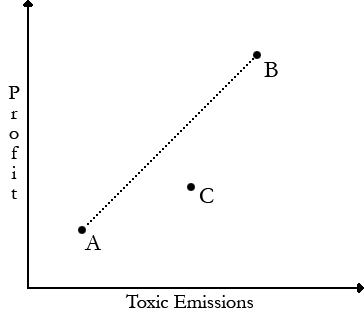Environment-Profit Trade-Offs
Trade-offs between environmental and profitability effects offer a helpful way to think about environmental values without relying on direct monetary measures. Environmental-profitability trade-off analysis involves two measures: an environmental one and a profitability one. Usually the environmental measure is in physical units (e.g., mass or density units), while the profitability one is in monetary units (e.g., revenues, costs, or net returns).
1. Efficiency Analysis:
Mapping alternative practices or policies by these two criteria can show which ones are "efficient" in the sense of giving the best profitability for a given level of environmental performance, or the best environmental outcome at a given profitability level. In the picture, alternative A gives lower profit but also lower toxic emissions than alternative B. Alternative C is not efficient compared with A and B, because C would create more toxic emissions or less profit than a mix of A and B (illustrated by the connecting line). Efficient choices will lie on a frontier, where there is a trade-off between improving profitability and environmental performance.

2. Trade-off Analysis:
The efficient alternatives that lie on the frontier permit trade-off comparisons. For example, one measure of the value of reduced toxic emissions by moving from B to A in the picture is the value of reduced profits that accompany such a move. More details on trade-off frontiers as well as radar diagrams can be found among the example studies at the bottom of this page.
3. Where to Get Data?
Profitability data generally come from budgets or cost estimates.
Agro-environmental indicator data on specific environmental attributes can be found in a variety of databases and simulation models. Agro-environmental data with links from this site include soil erosion, pesticides, water quality (including nitrate leaching and phosphorus runoff), and greenhouse gas emissions.
4. Examples of Environment-profitability Trade-off Studies in Agriculture
Two broad categories of trade-off studies exist. The first group uses trade-off frontiers to compare many alternatives across two dimensions. The second group uses radar diagrams to compare few alternatives across three or more dimensions.
- PEET:Pesticide Economic and Environmental Tradeoffs Decision-Support System (Oklahoma State University): This downloadable computer program implements analysis proposed by Hoag and Hornsby (1992).
Tradeoff Frontiers
- Profitability vs. Global Warming Impact: On pages 62-64 of this book chapter, Swinton et al (2015) describe efficiency and trade-off analysis across six alternatives using two dimensions (profitability and global warming impact).
- Tradeoff Analysis using Integrated Biophysical and Economic Models: This article by Stoorvogel et al (2004) describes and illustrates integrated bioeconomic modeling with two-dimensional trade-off analysis.
Radar Diagrams for Trade-off Comparisons across Multiple Dimensions
- Ecosystem-Service Tradeoffs: Radar (or "spider") diagrams are a useful way to communicate trade-offs among more than two traits. Meehan et al (2013) examine trade-offs across seven different ecosystem services from alternative cropping systems.



 Print
Print Email
Email